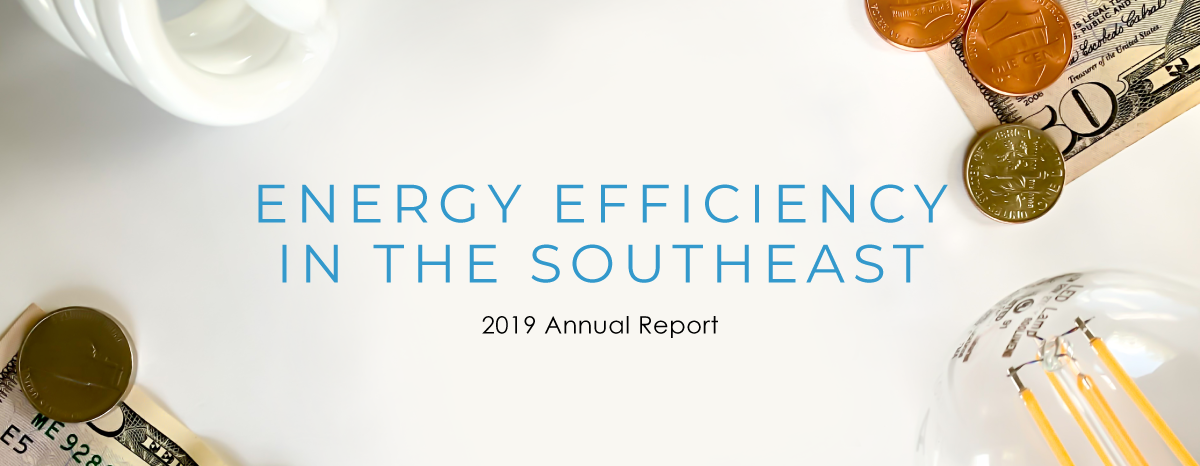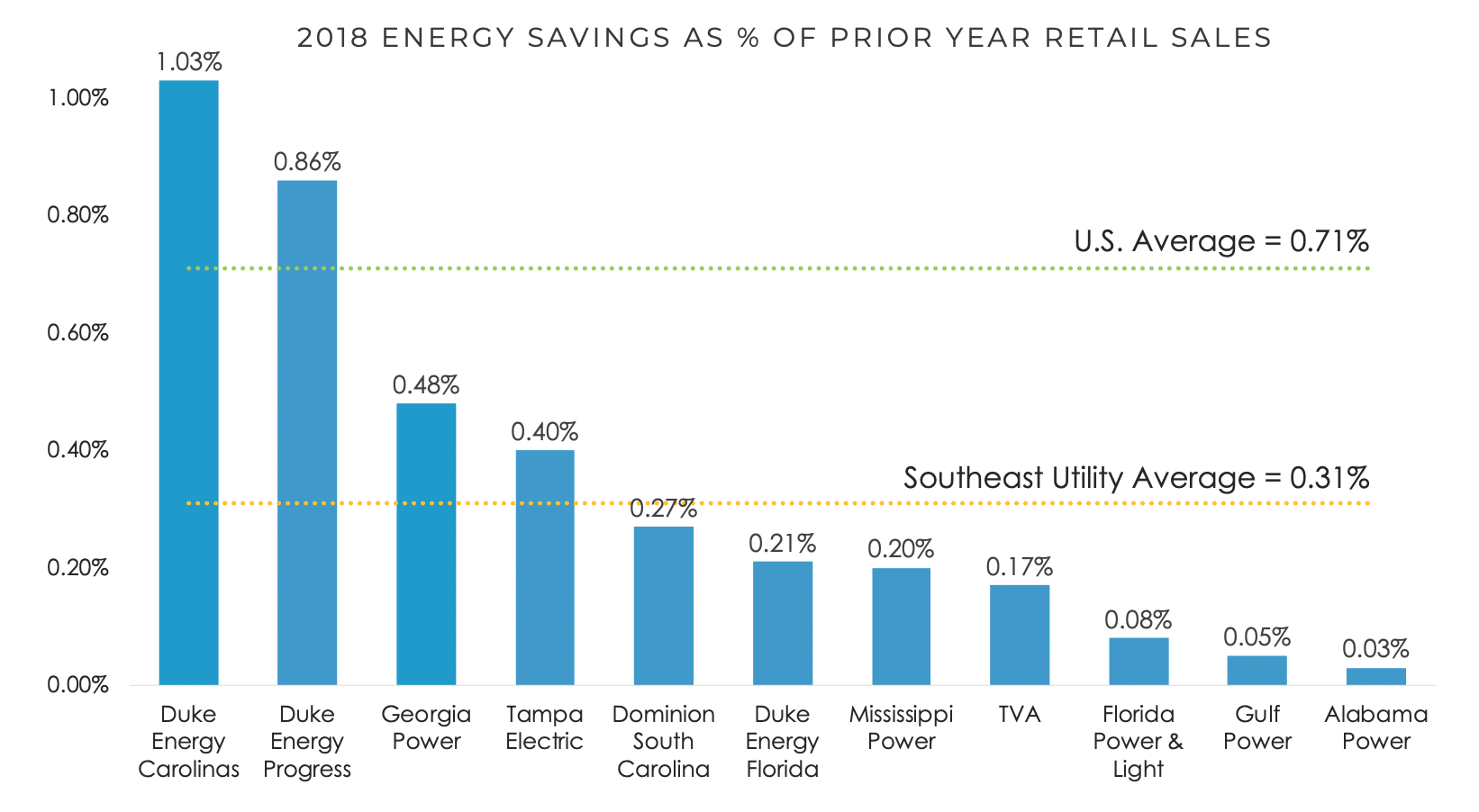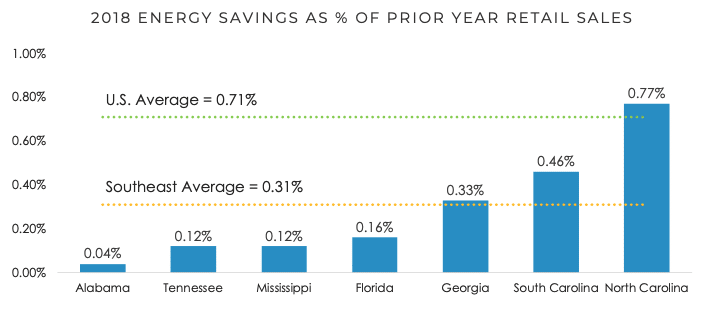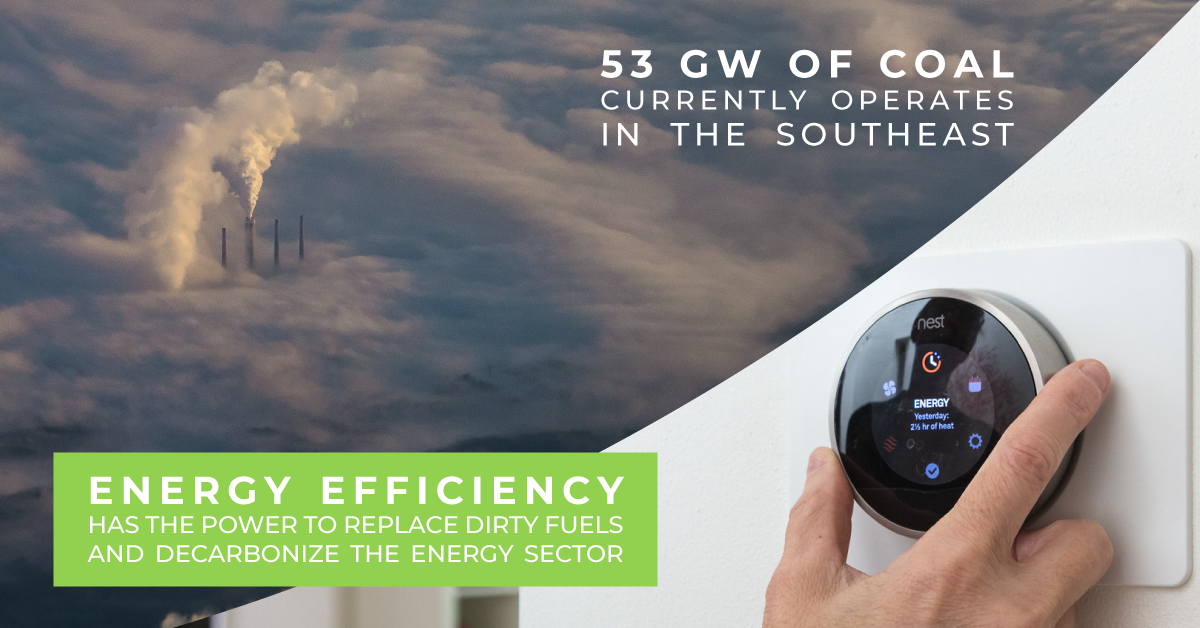SACE’s "Energy Efficiency in the Southeast" 2019 report shows that Southeastern states and utilities continue to rely on expensive, outdated, carbon polluting fossil fuel power plants while underinvesting in abundant low-cost efficiency resources. Duke Energy was again the clear regional leader, delivering over half of all efficiency savings for the Southeast.
Forest Bradley-Wright and Heather Pohnan | January 22, 2020 | Energy Efficiency, Energy Policy, Utilities
Energy Efficiency is a proven clean energy resource that has a critical role to play in helping reduce our region’s persistently high energy bills and cutting carbon emissions that worsen the climate crisis, threaten public health, and damage our environment. Electric utility energy efficiency programs offset the need for traditional fossil fuel power plants and are key to reducing utility system costs paid by customers on their monthly electric bills. Sadly, however, electric utilities and regulators in the Southeast consistently underinvest in this abundant low-cost energy efficiency resource. Instead, utilities in our region continue to rely on expensive, outdated fossil fuel power plants – including 53 GW of coal-powered generators – and are even proposing the construction of new ones. As a result, when compared to other regions in the US, the Southeast remains at the bottom of national efficiency rankings.
The Southern Alliance for Clean Energy’s (SACE) Energy Efficiency in the Southeast 2019 Annual Report utilizes data collected from 2018 to explore energy efficiency trends, identify policies and practices impacting energy efficiency savings for the region, and offer solutions for implementing this underutilized resource. By examining utility efficiency program savings, our second annual report unveils which of our region’s utilities are cost-effectively eliminating unnecessary energy waste, and which are simply selling more power.
DOWNLOAD THE REPORT WATCH THE WEBINAR
2018 UTILITY HIGHLIGHTS
Just a handful of utility systems make up the majority of energy savings in the Southeast. The utility systems displayed below accounted for approximately 99% of energy efficiency savings in 2018. To compare and contrast the performance of these utilities, SACE collects and analyzes detailed program savings data from annual reports and official filings submitted to regulators. By examining each utility’s energy efficiency program savings as a percentage (%) of the previous year’s annual sales, it becomes easier to see how utilities of different sizes view energy efficiency as a resource.

So, how did Southeast utilities stack up in 2018?
Duke Energy was again the clear regional leader and the only electric utility to deliver annual efficiency savings (0.79%) that exceeded the national average (0.71%). This achievement is supported by three key factors:
- Favorable policies in the Carolinas
- Company staff and management leadership with extensive multi-state experience
- Duke’s willingness to work with energy efficiency advocates to improve and expand program offerings, which is unrivaled in the region.
Duke Energy Carolinas, operating in North and South Carolina, continues to be the only utility in the Southeast to exceed one percent annual savings (1.03%), a symbolic checkpoint on the path toward the higher savings levels achieved by successful utilities in other parts of the country. Duke Energy Progress (0.86%), also operating in North and South Carolina, was also head-and-shoulders above the next major Southeastern utility energy efficiency leader. State policy differences meant far lower savings for Duke Energy Florida (0.21%).
Next in line, Georgia Power (0.48%) and Tampa Electric (0.40%) both exceeded the Southeast regional average (0.31%), but fell short of the national average (0.71%).
All other major Southeastern utility systems are substantially underperforming. The Tennessee Valley Authority (TVA) continues to drive efficiency savings downward for the states and utilities it serves (0.17%), and the Southeast’s largest utility, Florida, Power & Light (FPL), produced a trivial (0.08%) efficiency savings for its more than 4 million customers.
POLICY TRENDS

In the Southeast’s most populous state, Florida, the Public Service Commission (PSC) just completed another five-year cycle of efficiency savings targets for the state’s largest utilities. The Commission rejected utility proposals that would have in effect eliminated most efficiency savings targets altogether, instead choosing to retain previous energy efficiency goals that continue to place highly restrictive constraints on efficiency measures and set very low savings requirements.
Recent policy and regulatory developments, primarily at the state level, affect the ability to increase future energy efficiency savings. The carbon pollution reduction targets outlined in North Carolina Governor Cooper’s 2018 Executive Order 80 build on an already strong foundation that supports clean energy, and in 2019, Duke Energy announced plans to cut its carbon emissions 50% by 2030 across all its companies and simultaneously reach net zero carbon by 2050. Also in 2019, the North Carolina Utilities Commission ordered major changes in how Duke conducts integrated resource planning, including reworking how efficiency is modeled, requiring existing coal to compete against clean energy, and showing how its resource plans could achieve state and corporate emissions targets. Replacing fossil fuel generation to meet these emission targets represents a major opportunity for energy efficiency in North Carolina in the coming years.
In South Carolina, continued political fallout from the failed VC Summer nuclear plant led to significant turnover at the Public Service Commission and provided momentum for new clean energy policies like the Energy Freedom Act, approved unanimously by the state legislature in 2019. While Duke continues to be the major efficiency driver for South Carolina, the PSC recently approved a plan to double energy savings for Dominion Energy above the levels previously captured by South Carolina Electric & Gas before the corporate takeover.
Policy challenges still remain for energy efficiency in both North and South Carolina. For instance, despite huge savings opportunities in the commercial and industrial sectors, both states give large commercial and industrial customers an “opt-out.” As a result, many businesses do not contribute to either the cost of nor savings from, utility efficiency programs in the Carolinas, which greatly limits the amount of efficiency savings for both states.
HOW EFFICIENCY AND IRP RULES RELATE
Integrated Resource Planning (IRP), or long-term resource planning, can be an important driver for energy efficiency in many states. During Georgia Power’s 2019 IRP process, leadership by Chairman Bubba McDonald and the Georgia Public Service Commission led to a 15% bump in required efficiency savings for Georgia Power over the next three years and added a requirement that future supply additions must compete with efficiency resources directly. After a few years of relatively small-scale efficiency programs in Mississippi, the Commission enacted IRP rules for the first time in 2019 that included a significant focus on energy efficiency.

By contrast, TVA once pioneered this type of efficiency resource analysis in the Southeast. Actual performance fell far short of plans and today, TVA offers no direct efficiency rebate incentives for customers. In 2019, TVA’s IRP took a significant turn for the worse with unrealistic costs and spending caps that steeply reduced TVA’s planned future efficiency investment. In effect, TVA now has no overall efficiency resource strategy and provides minimal funding for low-income weatherization.
LOW-INCOME ENERGY EFFICIENCY
Utility energy efficiency programs are key to affordable energy, especially for households suffering from high energy bills and struggling with untenable tradeoffs. These customers often have to make tough choices between buying basic necessities like food, medicine, and transportation, or paying their energy bills, and frequently risk having their power cut off.

Florida presents a stark contrast between utilities that deliver strong efficiency savings programs for low-income customers and those who do not. Tampa Electric (TECO) was a standout with a low-income Neighborhood Weatherization program that reached more than 7,000 households in 2018, despite having a comparatively small customer base. The much larger Duke Energy Florida served more than 20,000 customers with its Neighborhood Energy Savers Program. By comparison, the state’s largest utility, Florida Power & Light, reached just 2,295 low-income households. Adjusted for utility size, TECO delivered 50 times more and Duke Energy Florida delivered 20 times more savings for low-income customers than FPL.
Duke in the Carolinas, Georgia Power, and TVA also took steps to increase efficiency savings for low-income customers in 2019, though the scale of need vastly exceeds what is currently planned. Georgia Power is now in the process of developing an on-bill tariff to finance upfront costs of efficiency improvements for low-income customers, the first by an investor-owned utility in the Southeast. Duke has been expanding the availability of deeper savings measures to assist low-income customers to achieve greater bill reductions, and TVA is matching funds raised by local utility companies to provide weatherization for low-income households.
DECARBONIZATION
Energy efficiency not only helps customers lower their electric bills, but it also removes the need to build expensive new fossil fuel generation, and facilitates the retirement of outdated, polluting coal and gas power plants. This is easier than ever with new technologies that allow customers to optimize their energy use and maximize carbon emission reductions.
Electrification provides opportunities to lower utility and transportation costs for consumers while cutting carbon emissions that drive global climate change. The Energy Efficiency in the Southeast 2019 Annual Report highlights the relationship between energy efficiency, strategic electrification, and decarbonization of the region’s power sector.

Some of the most promising electrification opportunities include:
- Switching from gas to electricity for heating, water heaters, stoves, and clothes dryers
- Lowering and optimizing energy use with smart appliances, devices, and meters
- Modernizing building codes and standards
- Shifting away from gasoline automobiles, commercial shipping, and public transportation
Electrification can increase electricity demand, but also helps to decarbonize our national energy system, since much of the power sector is already lower-emitting than direct fossil fuel use, and it is easier to shift electricity generation to renewable energy sources to further reduce carbon emissions. Meanwhile, energy efficiency helps offset the additional load created by electrification, thereby reducing carbon emissions from fossil fuel power generation. Together efficiency, electrification, and energy optimization can eliminate massive amounts of carbon emissions.
The Southeast has among the highest energy bills in the country and the lowest energy efficiency performance – but there is a clear solution: Before spending customer dollars on more expensive power plants, utilities should be required to first invest in all cost-effective energy efficiency and energy optimization. To do otherwise is to pay too much.
This blog is Part 1 in the series following the release of the Energy Efficiency in the Southeast 2019 Annual Report. To learn more about the findings of the report:
- Read Part 2 of the series showcasing regional leadership by North Carolina and Duke Energy: “North Carolina and Duke Energy Hold Commanding Lead on Energy Efficiency in the Southeast“
- Read Part 3 of this series looking at the relationship between energy efficiency and integrated resource planning in Mississippi: “Efficiency in Mississippi: Utilities Can Do More, Customers Deserve No Less.“
- Read Part 4 that examines how the largest utilities in the Southeast stack up with their national peers on energy efficiency.
- Watch a webinar where SACE technical staff discusses report findings.
- Additional blogs related to energy efficiency in the Southeast here.
For a copy of the 2018 report and corresponding blogs highlighting individual state and utility, click on the following links:
Energy Efficiency in the Southeast 2018 Annual Report
SCE&G at the Crossroads for Energy Efficiency
North Carolina and Duke Energy Far Ahead of Southeast in Energy Efficiency
Does Georgia Power Plan to Increase Its Financially Successful Energy Efficiency Programs?
Florida Power & Light Drags State to Bottom of Efficiency Rankings
#EEinSE2019